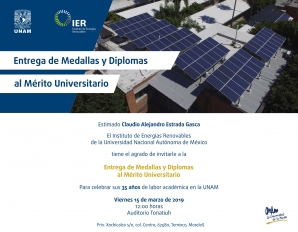Carlos E. Arreola-Ramos,Omar Álvarez-Brito,Juan Daniel Macías,Aldo Javier Guadarrama-Mendoza, Manuel A. Ramírez-Cabrera,Armando Rojas-Morin,Patricio J. Valadés-Pelayo,Heidi Isabel Villafán-Vidales and Camilo A. Arancibia-Bulnes
Abstract
Reticulate porous ceramic reactors use foam-type absorbers in their operation which must fulfill two essential functions: favoring the volumetric effect and increasing the mass and heat transfer by acting as a support for the reactive materials. Heating these absorbers with highly inhomogeneous concentrate irradiation induces high thermal gradients that affect their thermal performance. Owing to the critical function of these component in the reactor, it is necessary to define a selection criterion for the foam-type absorbers. In this work, we performed an experimental and numerical thermal analysis of three partially stabilized zirconia (PSZ) foam-type absorbers with pore density of 10, 20, and 30 PPI (pores per inch) used as a volumetric absorber. A numerical model and an analytical approximation were developed to reproduce experimental results, and calculate the thermal conductivity, as well as volumetric heat transfer coefficient.
The results show that an increase in pore density leads to an increase in the temperature difference between the irradiated face and the rear face of the absorber, this occurs because when pore density increases the concentrated energy no longer penetrates in the deepest space of the absorber and energy is absorbed in areas close to the surface; therefore, temperature gradients are created within the porous medium. The opposite effect occurs when the airflow rate increases; the temperature gradient between the irradiated face and the rear face is reduced. This behavior is more noticeable at low pore densities, but at high pore densities, the effect is less relevant because the internal structure of porous absorbers with high pore density is more complex, which offers obstructions or physical barriers to airflow and thermal barriers to heat transfer.
When the steady state is reached, the temperature difference between the two faces of the absorber remains constant if the concentrate irradiation changes slightly, even changing the airflow rate. The results obtained in this work allow us to establish a selection criterion for porous absorbers that operate within solar reactors; this criterion is based on knowledge of the physical properties of the porous absorber, the environment, the working conditions, and the results expected.

